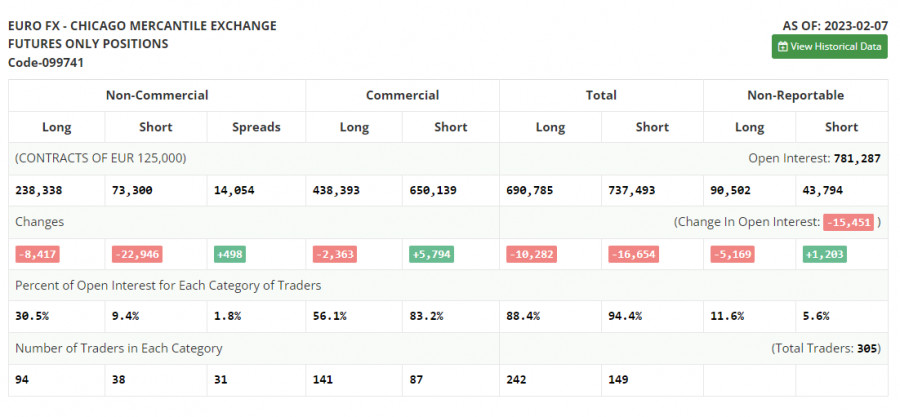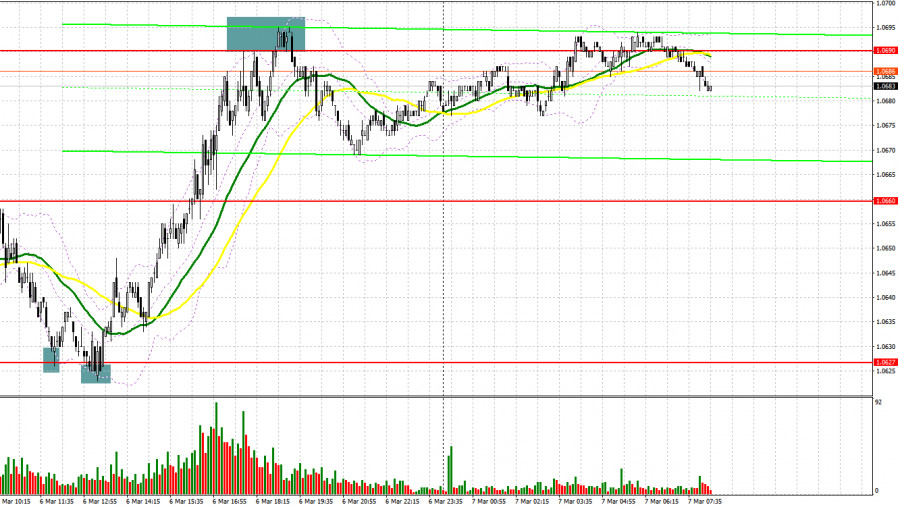
A few nice entry signals were generated yesterday. Let's look at the M5 chart to get a picture of what happened. In my previous review, I focused on the 1.0660 level and considered entering the market there. There was neither growth nor a false breakout at this level. The quote failed to test it. In the North American session, a false break at 1.0627 produced an excellent signal to buy, and the price advanced by more than 60 pips. Failed consolidation above 1.0690 made a signal to sell, with a view to a correction of 20 pips.

When to open long positions on EUR/USD:
Before giving an outlook for EUR/USD, let's analyze the situation in the futures market and see how the Commitments of Traders have changed. The COT report for February 7 logged a decrease in both long and short positions. Clearly, that happened after the decisions of the Federal Reserve and the European Central Bank on interest rates. In fact, COT data from a month ago is of little interest at this point as it is not relevant due to the technical glitch the CFTC recently suffered. Waiting for fresh reports is all that's left. In the near term, Fed Chair Jerome Powell will give testimony, which may determine the dollar's future trend for a month ahead. At the end of March, the FOMC meeting will take place. Hawkish remarks about inflation and monetary policy will drive the dollar up against the euro. If Powell says nothing new on the matter, the greenback is likely to show weakness. According to the COT report, long non-commercial positions decreased by 8,417 to 238,338. Short non-commercial positions dropped by 22,946 to 73,300. Consequently, the non-commercial net position came in at 165,038 versus 150,509. The weekly closing price fell to 1.0742 from 1.0893.

Volatility is expected to be quite low in the morning. No other statistics apart from Germany's factory orders are expected. Therefore, the trading plan will be to buy after a fall and a false breakout through support at 1.0662. The bullish moving averages are passing there as well. An upward target will stand at the 1.0693 resistance. In fact, the pair has unsuccessfully attempted to break above it for the second week now. After a breakout and a downside test of this range, the price will head toward 1.0731, targeting 1.0769 but already after Powell's speech. The most distant target is seen at the 1.0800 high. Should the price approach the mark, we would see a bullish continuation. This is also where I am going to lock in profits. If EUR/USD goes down and there is no bullish activity at 1.0662, which is highly likely, the market will reach an equilibrium that may last until Powell's testimony. In such a case, only a false breakout through support at 1.0627 will generate a buy signal. The trading plan will also be to buy on a rebound from the 1.0595 low, or even lower, at 1.0568, allowing a bullish correction of 30 to 35 pips intraday.
When to open short positions on EUR/USD:
The bears defended the 1.0693 mark, but there has been no strong downtrend from this level so far. The bulls will most likely try to break above this range in the morning, so the focus should be on this level. The primary goal will be to protect resistance at 1.0693, formed last week. A false breakout through this level after disappointing statistics in the eurozone will give a sell signal, targeting the 1.0662 area. A breakout, consolidation under 1.0662, and a reverse test to the upside will make an additional sell signal. The bullish stop orders will trigger, pushing the pair to 1.0627. A break above this level could only be expected after Powell's hawkish statements as there no other statistics are due to come. The target is seen at the 1.0595 support where I am going to lock in profits. In case of growth in EUR/USD in the European session and the absence of the bears at 1.0693, the bulls will retain control over the market. The trading plan will be to open short positions after a false breakout at 1.0731. On a rebound, the instrument could be sold at 1.0769 or 1.0800, allowing a bearish correction of 30 to 35 pips intraday.
Indicator signals:
Moving averages
Trading is carried out above the 30-day and 50-day moving averages, indicating a bullish continuation.
Note: The period and prices of moving averages are viewed by the author on the hourly chart and differ from the general definition of classic daily moving averages on the daily chart.
Bollinger Bands
Resistance is seen at 1.0710, in line with the upper band. Support stands at 1.0635, in line with the lower band.
Indicator description:
Moving average (MA) determines the current trend by smoothing volatility and noise. Period 50. Colored yellow on the chart.Moving average (MA) determines the current trend by smoothing volatility and noise. Period 30. Colored green on the chart.Moving Average Convergence/Divergence (MACD). Fast EMA 12. Slow EMA 26. SMA 9.Bollinger Bands. Period 20Non-commercial traders are speculators such as individual traders, hedge funds, and large institutions who use the futures market for speculative purposes and meet certain requirements.Long non-commercial positions are the total long position of non-commercial traders.Non-commercial short positions are the total short position of non-commercial traders.Total non-commercial net position is the difference between the short and long positions of non-commercial traders.